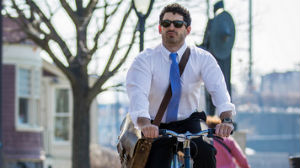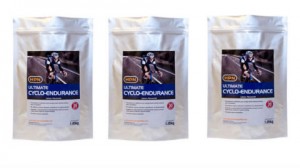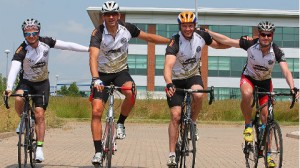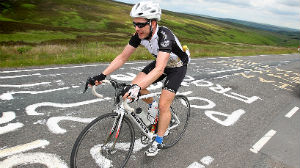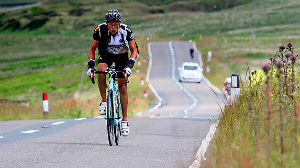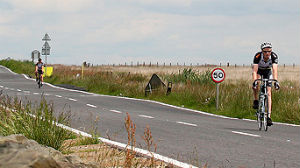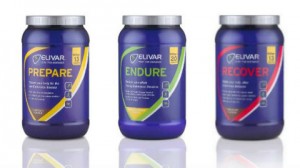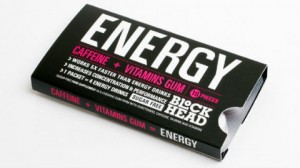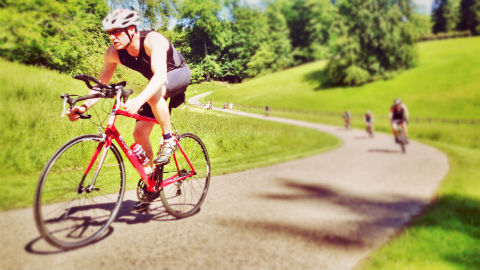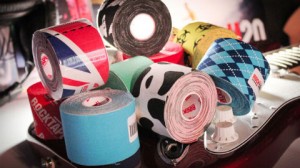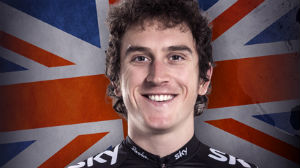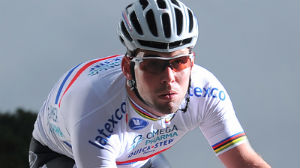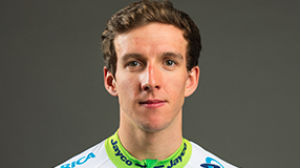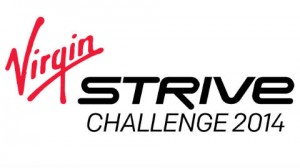 Taking place from August 7 to September 6 The Virgin STRIVE Challenge is a mass participatory, ultra-endurance fundraising event organised by Sam Branson and Big Change, which will see a core team including Innocent Co-Founder Richard Reed, adventurer Justin Packshaw and Wimbledon Champion Marion Bartoli run, row, cycle, hike and climb from London to the summit of the Matterhorn. Virgin STRIVE Challenge aims to raise £750,000, which will go directly to the Big Change Life Skills projects; Big Change is a charity focused on giving young people in the UK an opportunity to learn and develop the soft skills they need to become healthy, happy and productive adults. Cyclo spoke to Sam Branson to find out how it all began and how everyone can take part…
Taking place from August 7 to September 6 The Virgin STRIVE Challenge is a mass participatory, ultra-endurance fundraising event organised by Sam Branson and Big Change, which will see a core team including Innocent Co-Founder Richard Reed, adventurer Justin Packshaw and Wimbledon Champion Marion Bartoli run, row, cycle, hike and climb from London to the summit of the Matterhorn. Virgin STRIVE Challenge aims to raise £750,000, which will go directly to the Big Change Life Skills projects; Big Change is a charity focused on giving young people in the UK an opportunity to learn and develop the soft skills they need to become healthy, happy and productive adults. Cyclo spoke to Sam Branson to find out how it all began and how everyone can take part…
Cyclo: An incredible challenge for everyone; who did it all begin?
Sam Branson: I climbed Mont Blanc two years ago to launch our foundation Big Change which we are doing this challenge for. So I was up on the mountain and thinking that whenever I push myself in life with the challenges I have undertaken, I have always thrived and learned so much about wider life skills. I looked across and saw the Matterhorn and though, ‘Wow! What an iconic mountain how awesome to climb that…’
It started me thinking how can I come up with a challenge to be a vehicle for talking about the feelings and skills one gains when you set a challenge and push yourself to achieve it. I began to put together a plan to get from the Matterhorn to London and then I got an email from my cousin Noah saying, ‘I have an idea, why don’t we go from London to the Matterhorn?
We met up for a beer not believing we had basically both come up with the same thing. We knocked heads together and STRIVE was born. It all grew from there, it’s been a long process but I think we’re just about starting to reap the benefits…
Cyclo: How did the route and combination of challenges come about?
Sam Branson: We had settled on London to the Matterhorn and if you’re basically going from A to B things quite naturally fall into place; it was kind of obvious to run to the coast, row the channel, cycle, hike and climb.
Cyclo: Any change of plans or options you discounted?
Sam Branson: We were going cycle straight to the Matterhorn but decided to add in The Haute Route just to throw in another element to the mix and try and get more people involved. Yes we have a core team, but the real aim of this is to try and make it accessible to as many other people as possible, to get them to be a part of it too.
One other option we had in terms of sporting challenge was to swim the channel, but I have to say that had we gone with that decision I don’t think many of us would have made it all the way…
Cyclo: How did you go about gathering your core team for this?
Sam Branson: We set out to find people that really reflected what STRIVE were about. Those who strive in life, work hard and with dedication. We wanted people from different walks of life and who have excelled in their own way, those who have stuck their neck out and have reaped the benefits.
We needed people who had the time and passion of course, but also who were capable of doing it. The thing with these kinds of events is that you do ultimately attract the kind of people who are right. I think the fact that it’s massive, iconic and for a great cause helped, so the people who said yes said yes pretty quickly.
Cyclo: You needed people capable of tremendous teamwork too…
Sam Branson: Well all those life skills, like teamwork and emotional communication, are fundament to help us get along the way. Of course we wanted to create a vehicle that raised funds but also one that really highlighted these life skills. We’re going to be creating content along the way and talking about what we are using to get through it. Teamwork will be, without a doubt, chief amongst those – everyone has high moments and low moments and that’s when you need to drawn on the strength of others.
Cyclo: Both cycle stages look incredibly challenging but the second one in particular with over 8,000m of ascent…
Sam Branson: With the cycling we wanted to try and work out a way of getting as many people as possible doing this. I think for people who cycle a lot the second legs is challenging enough to make them feel like they are really pushing themselves and having a great experience. For those who might not have ever cycled or have cycled less the first leg is a great way of getting people involved a multi-day cycling. Both cycle legs will, I’m sure, be spectacular…
Cyclo: Are the big hills something you are dreading?
Sam Branson: The fact is I find the flats with headwinds ten times harder than any hill I have ever cycled up. You have that sense of achievement on the hills; you have a visual goal, you get up to the top, feel amazing, and then have all the fun of cycling down the other side.
Cyclo: Apart from donating – which we hope plenty of our readers will – how else can people get involved?
Sam Branson: Donating’s great, that’s via uk.virginmoneygiving.com but we want as many as possible along on the run and ride, all the details are at strivechallenge.com – it’s going to be great fun…
The full Virgin STRIVE Challenge will comprise three marathons in three days, 36km cross-Channel row, 1047km of cycling, 180km, 7-day hike of the Haute Route Trek and the ascent of the Matterhorn. The core team consists of Sam Branson, Richard Reed (Innocent Co-Founder), Marion Bartoli (current Wimbledon Champion), Karl Lokko (poet and social activist), Ade Adepitan (broadcaster and paralympian), Justin Packshaw (adventurer), Fiona Waller (trans-Atlantic and Indian ocean rower), Arnaud Haines and Noah Devereux (event co-founder and director).
The cycle stages (and marathons) are open for mass participation:
Cycle 1: Boulogne-sur-Mer to Troyes, 449km, 4099m of climb, August 12-17
Cycle 2: Troyes to Verbier, 598km, 8643m of climb, August 17-22
Further details and online entry at strivechallenge.com
More information on Big Change at bigchangecharitabletrust.org
Donate now to the Virgin STRIVE Challenge at uk.virginmoneygiving.com

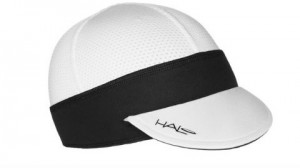 The Halo products – various nifty anti-sweat headbands and bandanas – have been available in the UK for a few years now, but the latest addition of a dedicated Halo Cycling Cap grabbed Cyclo’s attention. Exceptionally lightweight at just 40g the Halo Cycling Cap fits comfortably under any helmet with the stretch fabric mesh upper adding little or no bulk and breathing well on the ride. The lower band, also with good stretch, can be worn either above or over the ears – the latter offering a little added comfort to winter rides no doubt.
The Halo products – various nifty anti-sweat headbands and bandanas – have been available in the UK for a few years now, but the latest addition of a dedicated Halo Cycling Cap grabbed Cyclo’s attention. Exceptionally lightweight at just 40g the Halo Cycling Cap fits comfortably under any helmet with the stretch fabric mesh upper adding little or no bulk and breathing well on the ride. The lower band, also with good stretch, can be worn either above or over the ears – the latter offering a little added comfort to winter rides no doubt.

